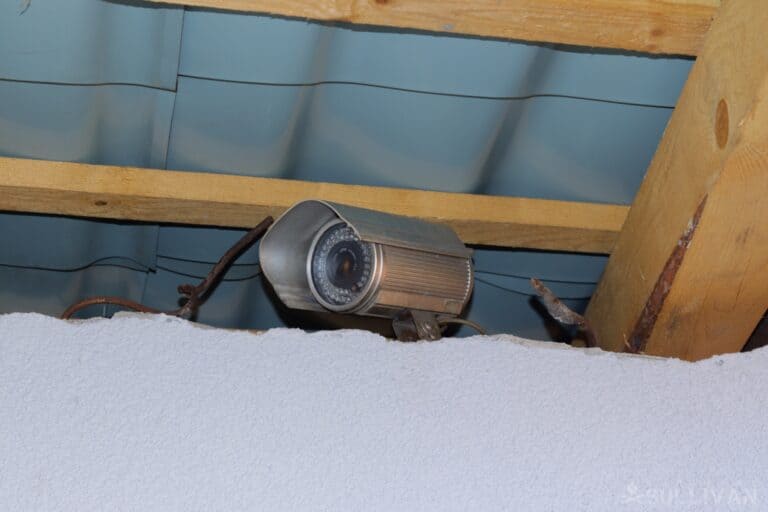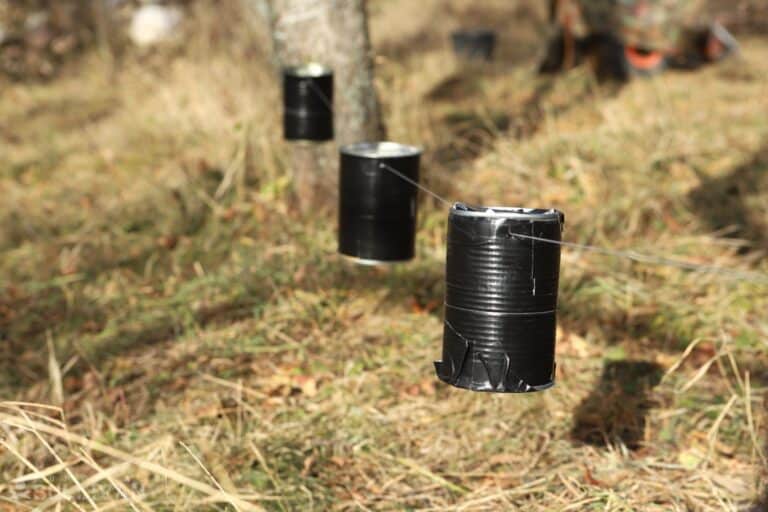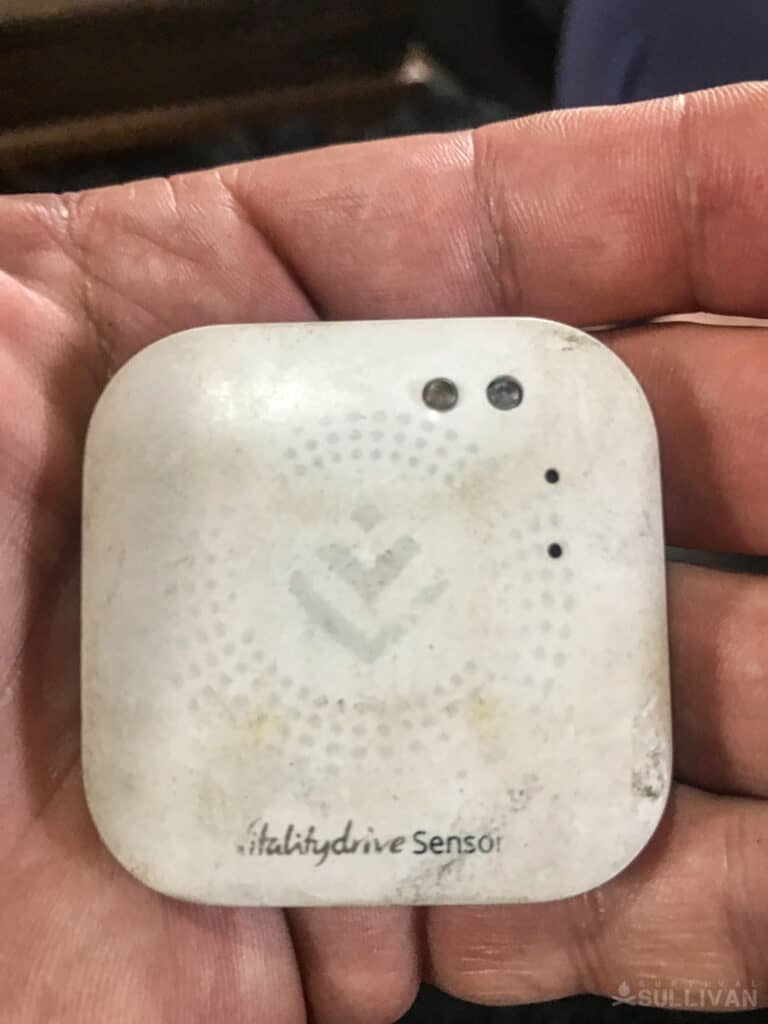When in a survival situation, intruders are always a major concern. This could be looters, military, or just kids looking to vandalize a house.
Having a home defense system is important, but early detection is the key to protecting your home. Unfortunately, this applies to everyday life as well.

Home intruders are a major concern 24/7 in this country. The U.S. averages about 3.6 million home invasions, and about 30% of them happen with somebody home.
The average loss is about $2,300, and they most often happen during the day when somebody is at work. So what can we do about it?
You have options, but before you decide what to do in a panic, it would be best to know they are coming. That is why you need early warning systems for your home and surrounding property.
Advanced warning of approaching danger, or potential danger, is essential for acting quickly and correctly.
This article will give you a master class in early warning theory and implementation, and plenty of options for equipping your home and property.
Table of Contents
What is the Purpose of Early Warning?
Before we can determine what is best when it comes to early warning components of an integrated and holistic home security system, we must first determine the purpose of the same.
Why do we need advance notice of who is at, or approaching, the physical perimeter of our home?
The answer is twofold: detection and time. Detection comes in the form of knowing in advance that someone or something is approaching.
The ability to know in advance that an individual or a group of individuals are at your doorstep can help avoid dangerous surprises, as well as give you time to prepare and protect yourself and your loved ones.
This is especially important for those who are at risk of violence or harassment, such as victims of domestic abuse.
Time is so often paramount in emergent or dangerous situations as it allows us more opportunity to process information and implement a quick and accurate response to whatever it is we are facing.
Time is literally life in a conflict. You can never have enough time on your side!
If surprise and speed are the two best tools assailants have to perpetrate their work on us, then it is detection and time that will foil them and give us the best chance for success.
Near Detection vs. Far Detection
When we look at the different ways to detect an individual or a group, we can broadly break them down into two categories: near detection and far detection.
Both have their own unique benefits that can be leveraged to create an effective home security system.
Near detection is exactly what it sounds like: devices or sensors that are placed close to or upon the physical perimeter of your property that can detect when someone or something is near an entryway, or moving though one.
These devices may or may not be electronic in nature, are often smaller and unobtrusive compared to their far-detecting counterparts, making them ideal for placement around the home without drawing too much attention.
They also tend to be less expensive, making them a more affordable option for those on a budget.
Even better, compared to bygone decades these devices are amenable to DIY instruction.
One of the most popular and well-known examples of a near-detecting device is the doorbell camera. These small devices are placed next to your front door and wirelessly connected to your home security system or used standalone.
When someone steps onto your property and triggers the motion sensor, the doorbell camera will begin recording and send an alert to your phone or security panel, letting you know that someone is there.
You can then see and speak to the person at your door using the two-way audio feature, all from the safety and comfort of your home.
Doorbell cameras are a great example of how near detection devices can be used to create an effective home security system, but they are far from the only option.
Other typical examples are window or door sensors that can trigger an alert or even sound an alarm whenever opened.
Far detection devices are, as you might have guessed, placed further away from the physical perimeter of your property and often used to surveil your surrounding lands or curtilage.
These devices are often larger and more expensive than their near-detecting counterparts, but they make up for it in range and detection accuracy. These devices are typically electronic if they are to be repeatable in operation, but not always.
One of the most popular examples of a far-detecting device is the trail cam or outdoor security camera.
These cameras can be placed and camouflaged anywhere outdoors, including on fence posts or attached high up in trees.
When they detect motion in their field of view, they will begin recording and, for sophisticated models, send an alert directly to your phone or security panel, letting you know that someone is there. You can then review the footage to see what or who triggered the alarm.
Other options for far-detection sensors include simple motion detectors, pressure sensors that trip when stepped on, and more.
If you want to go old-school, you can even set up DIY perimeter alarms made from tin cans that don’t require any electricity in order to work.

Why Would One Choose Near or Far Detection?
Now that we’ve looked at the two main types of detection devices, it’s worth taking a moment to ask: why would someone choose one over the other?
The answer to this question largely depends on what your specific needs are and where you are in terms of security.
For example, if you live in a relatively safe neighborhood and have few concerns about people or animals entering your property uninvited, then near detection may be more than enough for you.
These devices are less expensive, easier to install, and often inconspicuous. They can also act as a deterrent to would-be intruders by letting them know that your home is monitored.
On the other hand, if you live in a more rural area or have concerns about more sophisticated forms of poaching, burglary, and other trespassing then far detection may be a better choice.
These devices offer increased awareness of your property and can provide greater time to orient yourself, assess, and make a decision, making it easier to detect unwanted activity on your property.
They can also provide footage or other evidence of deed should an incident occur.
Ultimately, the decision between near and far detection devices comes down to what you are trying to protect and how much you are willing to spend.
Equipping even a large house with a few perimeter cameras, first floor door and window sensors and perhaps a few other specialty early warning gadgets is comparatively affordable.
Covering a large bound or ranch with sensors at all gates and likely crossings, along with cameras at strategic points, will get expensive and fast.
Installation of these far-detection options is more expensive, generally, than near-detection sensors.
Both options have their pros and cons, so it’s important to consider your specific needs before making a purchase.
Overt vs. Covert Installation
Another key distinction to make when selecting early warning devices is between overt and covert installation. Overt installation is when the device is placed in plain sight and its purpose is known to all who see it.
A home security system with cameras mounted on the front of the house is a good example of an overt installation. When you see cameras, you know someone is watching and/or you are being recorded!
Conversely, covert installations are designed to be hidden from view or disguised as something else.
For instance, you might have a camera installed inside a fake rock near your front door or a pressure-sensitive sensor beneath the planks of your deck.
Some covert installations are just hard to see, being tiny like a pinhole camera or just designed to blend in with its surroundings.
There are advantages and disadvantages to both approaches…
Overt Installation
The main advantage of overt installation is that it acts as a strong deterrent. If would-be intruders know that your home is being monitored, some may be much less likely to attempt a break-in.
The downside of overt installation is that it can be more easily discovered, disabled or circumvented by someone who knows what they are looking at.
An overt installation might attract trouble if savvy thieves suspect there is something worth protecting (and worth their time) behind the layers of security!
Covert Installation: The advantage of covert installation is that it can be more difficult to find and disable. This is especially true if the device is well hidden or disguised.
The downside of covert installation is that, because it’s not in plain sight, it may not serve as much of a deterrent.
This may work to your advantage, however, because it does not advertise a “ready” or security-conscience posture. Combined with an overall life plan of OPSEC and PERSEC, this can work to your advantage.
You might employ both overt and covert options in tandem as part of a plan of misdirection.
For example, you could have overt cameras monitoring the entrances to your home while also employing covert sensors as a backup or in more vulnerable areas.
If an intruder is focused on one element he can see he likely won’t try to defeat one that he cannot unless he is quite sophisticated.
This approach can help to make your defense harder to predict and make you a more difficult target.
Considering Professional vs. DIY Installation
Some home security systems are designed for professional installation while others can be installed by the homeowner. Some may be installed by either. This is another important consideration when making your selection.
Professional Installation
The advantage of having a professional install your system is that it will likely be done correctly the first time and to local code.
A professional installer will know how to properly route and conceal wiring, which can make your system more difficult to disable.
The downside of professional installation is that it can be expensive and you may be tied into a contract with the security company.
Purpose designed, hard-wired systems are often more difficult to breach or disable, but will be more reliant on propriety or cumbersome hardware (monitoring stations, etc.)
DIY Installation
Installing your own system has the advantage of being less expensive (or free if you use a wireless system). You will also have the satisfaction of knowing that you did it yourself!
The downside of DIY installation is that it can be time-consuming and you may not do it as well as a professional.
This could leave your home vulnerable if the system is not installed correctly.
“Ala carte” DIY security systems and early warning devices are more vulnerable to breach or intrusion, but have the advantage that they readily integrate into modern “smart” info systems and devices.
When deciding whether to have a professional install your system or do it yourself, consider your own skills and abilities.
If you are not confident in your ability to install a security system correctly, it is best to leave it to the professionals.
However, if you are willing to take the time to learn and have some basic tools and supplies, you can save money by installing your own system.
Primitive and Improvised Early Warning
Not all useful early warning systems need to be intricate electronic contrivances.
A few well placed “tripwire” alarms (essentially a string or wire stretched across an opening with a can or other noise-making device attached) can give you time to react even if they are not very sophisticated.
The same is true of door and window alarms that use simple mechanical switches connected to buzzers, bells and other noisemakers.
Some early warning systems are visual, in the form of lights that turn on or blink when a switch connects a circuit after being trod on or disturbed.
This can even be done with scavenged materials afield: a mousetrap and a common snap light strung with a tripwire or jiggle trigger will illuminate when activated. If you have line of sight to the light, you’ll know someone is near!
For remote use or monitoring large tracts, electronics seem mandatory, but not so fast!
A simple “booby trap gun” consisting of a safe 12 gauge blank in an appropriate device will let everyone near and far know that it was activated, and might be enough to cover large swathes of land if setup in number.
Inside the home, even the most innocuous things can be put to use as “danger close” early warning systems.
The squealing hinges of an outside door, the one that you can never open quietly!) or the creaking planks of a vintage hardwood floor can give you a last-minute notice of a creeping cat burglar or stealthy assassin.
Think through your space before addressing these annoyances or resorting to expensive off the shelf-equivalents!
Remember, the goal here is not to make it impossible for someone to get past your early warning devices undetected, but rather to give you time to react and take appropriate measures.
Any of these systems can be augmented with a simple alarm, or even just a shout out to warn friends and family that trouble is afoot. A few seconds warning is enough to turn the tide!
Dos and Don’ts for Your System
You DO want to have the choice of how to deal with the intruder once alerted. You DON’T want the system to act as a booby trap and automatically injure or kill the intruder.
This may look cool in the movies, but in most cases it is illegal and dangerous. It is easy for a family member or friend to accidentally trip the system.
You DO want a system that covers all windows and doors for your building. You DON’T want it to be difficult to escape if you need to run. Early warning systems should be passive and non-obtrusive so you can run out a door any time you need to.
You DO want your system to reliably trip when somebody tries to break into your home. You DON’T want your system to be so sensitive that it has regular false alarms.
You DO want your system to provide thorough, hassle free security. You DON’T want it to require constant monitoring.
You DO want to use technology if you can afford it. You DON’T want to spend your life savings on a system.
If you are alerted of an intruder, you have a few options for actions you can take. The best plans involve a combination of these actions. Here are steps you could take when alerted of an intruder:
- Gather your family in a secure room. Pick a location that can only be entered from one direction. Pay special attention to children, the elderly, or the disabled as they will need extra help.
- If you have a weapon, have it nearby. This could be a firearm or even just a blunt object. You have to plan for the worst and hope for the best. Always assume that intruders mean you harm.
- Contact the authorities if possible. Ideally, you should have somebody other than yourself designated to call 911 in this situation. If this is a large scale survival situation, you may need a neighbor to contact in place of the police.
- Focus on a choke point. You want to have a narrow channel between you and the intruder. Hallways and staircases are great for this. It forces the intruders into a small, exposed area allowing you to easily defend your family. It also is one of the few situations where one person can defend against multiple intruders as they are forced into a one on one situation.
Types of Systems
Standard Security Systems – These are your normal systems that many urban and suburban homes have installed. They normally have magnetic sensors on the doors and windows.
The alarm has a keypad to disarm it and is tied to the authorities by either phone lines or a cellular signal. You can even set up these systems to remotely lock your doors, close your garage, and turn on your lights if you are willing to pay the fee.
Pros: Well advertised to deter thieves, loud, reliable detection, unlikely to have false alarms, can be controlled when away from home
Cons: Have high maintenance, dues, and installation costs, no better than an alarm during a widespread emergency, lines can be cut and signals can be blocked.
Disclosure: This post has links to 3rd party websites, so I may get a commission if you buy through those links. Survival Sullivan is a participant in the Amazon Services LLC Associates Program. As an Amazon Associate, I earn from qualifying purchases. See my full disclosure for more.
Cameras – These have been used for years to deter crime, alert of crimes, and catch criminals. You can install digital cameras over your entrances to catch intruders.
Most can be set to sound an alarm when motion is detected. You can also stream the video to your phone or computer, but there is typically a fee required.
Pros: Shows who the intruder is, no ongoing cost, easy to install
Cons: Somebody must monitor the feed, motion causes false alarms, notifies authorities

Silent Alert Alarms – These are fairly new systems that detect either motion or body heat and send a text message to your phone. There is no sound so it is not intended to scare away the intruder.
Pros: This works well if you are away from home, allows you to catch them in the act, allows you to check out the situation for false alarm, inexpensive
Cons: Does not alert the authorities, has an ongoing fee, prone to false alarms, does not scare off the intruder
Standard Motion Sensors – These have been around for a while and are typically tied to an alarm or a flood light. The light is much more subtle in just letting intruders know you are watching, while the alarm is much more direct.
They can be installed easily and have virtually no ongoing maintenance. You can also take motion sensors with you in bug-out scenarios.
Pros: Inexpensive, the light is ideal if you expect false alarms, detects all movement including people, animals, and vehicles
Cons: No ties to authorities, prone to false alarms, cannot be shut down remotely, does not alert you when away from home.

Dogs – The use of dogs as early warning systems is a time-honored tradition.
Dogs have an amazing sense of smell and can be trained to bark or otherwise signal when they detect something out of the ordinary.
Even untrained dogs will usually alert when they perceive something moving or present nearby! This is excellent capability to have on your side.
The downside of using dogs is that they require food, water, shelter and exercise; and they can be noisy, destructive and hard to control in large numbers.
A trained dog is an asset on patrol, but untrained “yap box” early warning is only really useful inside the home for the near detection game.
So long as your dog only really barks at people or large animal intruders to your space, leave them be!
If you care to invest the thousands of dollars necessary for the cause, training a suitable dog in actual detection or patrol work can be an invaluable addition to your security plan.
A smart, trained dog is virtually inescapable, especially when he is working his home turf!
Nonetheless, do not be so quick to stamp out your canine companion’s urge to sound off whenever someone or something is approaching the perimeter. You might be squelching a warning that could save your life one day!
Pros: They develop a sense of loyalty, even their appearance scares most intruders, they can detect intruders before security systems, can physically attack intruders, require no power, work when you are away from home
Cons: Expensive long term costs, can turn on their owners, no connection to authorities, could get hurt while defending home
Trip Wires – We are not talking about hooking up trip wires to explosives like you see in the action movies, but trip wires are effective early warning systems. You can rig wires near doors and windows and attach several noise-making devices.
You can hook it to a loud electric horn, or can just use bells or a can with rocks inside.
This is just designed to give you enough noise to let you know somebody is there. Trip wires are also ideal for bug-out situations where you may be sleeping in the woods. They will detect animals as well.
Pros: Inexpensive, reliable, easy to set up, low tech.
Cons: Prone to false alarms, no ties to authorities, can be cut if seen.
Other Early Warning Systems
These systems are not only designed to warn against home invasion. Here are some other early warning systems you may want to consider:
- Carbon Monoxide detectors – This should be in every household, and you can buy portable ones for camp sites as well.
- Smoke Detectors – We have one in almost every room in our home.
- Low Temperature Alarm – This can be helpful during the winter to ensure against frozen pipes, especially if you have an old heater.
- Water Sensors – These devices detect water or added moisture that could result in safety concerns or property damage. They are ideal for flood zones and hurricane areas, but can be helpful anywhere.
A Note on Large Scale SHTF Scenarios
There is one note of caution I must make on these early detection systems. Most of them are not nearly as valuable in major disasters.
What I mean is that most rely on some combination of power, available emergency services, and a cellular signal or working phone lines. Think about that for a second.
If we face a large natural disaster such as a hurricane, earthquake, or tornado, our system could be useless. Even if we are not directly hit, cell towers could be taken out, power lines dropped, and emergency services overloaded.
The roads could be flooded or blocked with trees. If you still have power the alarm may go off, but blowing or falling debris will cause false alarms as well.
If we face any type of foreign or domestic military action, there are issues. Ties to emergency services may be severed as well as normal communication lines
You may choose to get off the grid and use a generator, but you likely will not want to use your juice on cameras or motion sensors when you have a family to feed and keep warm.
Any type of EMP blast would take out the system completely. Military would also be trained to disarm these systems before breaching a structure.
Of course if you feel the need to leave your home, most of these systems will not come with you. Chances are that if you fear a home invasion, you may consider bugging out. You will still need to protect your camp against invasion, so low tech may be the way to go.
Whether you are securing your home or heading for the hills, trip wires, motions sensors, and dogs will always help. Be aware that motion sensors typically require batteries, so extras need to be packed.
Keep the Out and Keep them Off
To build a comprehensive and fail-safe early warning system for your home, it’s important to consider what you want the early warning device or system to do.
There are many different types of devices that can be used in these situations, from simple alarms which sound when someone is detected near an area covered by the alarm sensor, all the way up to sophisticated electronic systems that can monitor and record activity in a designated area.
In most cases, it is advisable to use a combination of different devices to create an early warning system that covers all the bases.
In the end the choice is yours. Do you want to focus on the guy trying to steal your television over the holidays, or do you want an early warning system that would be effective in any scenario?
As always, a combination of these solutions is the best answer. Hopefully this guide will help you find the right option for your household.

My name is Ryan Dotson and I am a survivalist, prepper, writer, and photographer. I grew up in the Ozark Mountains and in the foothills of the Pocono Mountains. My interest in survival started when I was in Boy Scouts and continued as my father, uncle, and grandfather taught me to hunt and fish. In the last few years I have started taking on survival challenges and have started writing about my experiences. I currently live in Mid-Missouri with my wife Lauren and three year old son Andrew.

Aussie prepper
Made up a e-field detector. Detects the disturbances to the earths electric (mot magnetic) field caused by a person, animal and infortunatly storms, earthquakes etc, but can be disquised as an electric fence and trigger an alarm when someone comes within about 10 feet of the sense wire. Can be Km long if needed but must be well insulated.
Low power consumption, easy solar powered with wifi alarm to mobile phone or computer etc. Multiple units are cheap to make (mine is based on old valve (tube to you Americans) technology) but can be solid state designed.
Due to the design being able to cope with the 100’s volts per meter above ground of the Earths field, its reasonably emp proof.
Also, people, dont forget communications during SHTF times. Ham radio is ideal, but a good quality 80 channel UHF CB and high outside antenna will get a long way, especially if the radio in your wifes car has a decent outside antenna as well. Dont forget battery powering your comms gear with solar charging as there will be no grid.
Bye for now, temperature is now 38 degrees c and its only 9:30 am.. Gonna be a scorcher today.